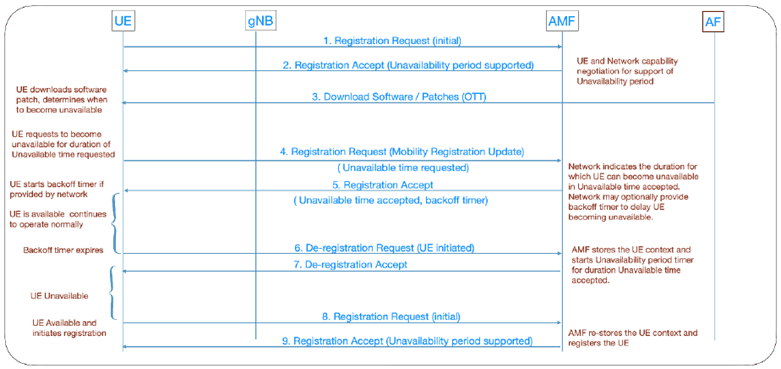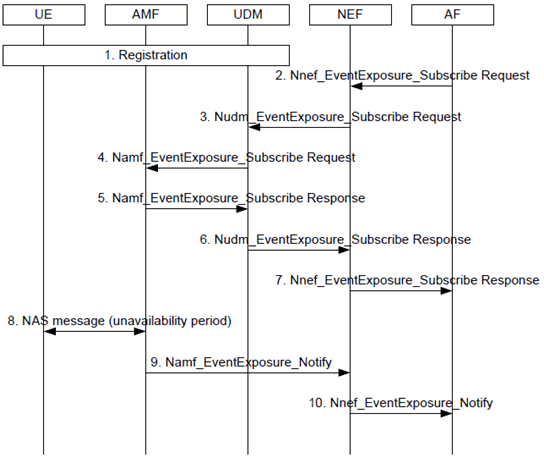Content for TR 23.700-61 Word version: 18.0.0
6.3 Solution #3: Determination of unavailability period in 5GS
6.4 Solution #4: Exposing UE provided unavailability period via Loss of Connectivity event subscription
...
...
6.3 Solution #3: Determination of unavailability period in 5GS p. 12
6.3.1 Introduction p. 12
This solution addresses Key issue #1.
6.3.2 Functional Description p. 12
This is a solution to Key Issue #1, "Determination of unavailability period in 5GS for a specific UE".
In this solution, the unavailability period is requested by the UE from 5GC. Once requested, the UE-requested unavailability period can be delayed by the 5GC with a backoff timer, if necessary.
The UE and network undergo capability negotiation wherein the UE indicates its capability to support Unavailability period and the network indicates its capability to support and use the Unavailability period in 5GS as part of the initial registration procedure.
The UE may download software, patches and other updates from AF. When the UE determines the appropriate time to become unavailable, UE initiates the Registration procedure for mobility and periodic registration update. The UE indicates the duration for which it may become unavailable, and the network may accept the unavailability duration indicated by the UE or indicate a different value.
The AMF may also reject the UE request to become unavailable if it is currently not appropriate for the UE to become unavailable. The AMF may optionally provide a backoff timer to the UE, if it is appropriate for the UE to become unavailable after a certain duration. If the UE receives a backoff timer, the UE starts the backoff timer and delays becoming unavailable for doing internal updates. While the backoff timer is running the UE is available and normal operation continues.
Once the backoff timer expires, the UE initiates De-registration procedure and becomes unavailable. The AMF stores the UE context and starts an internal timer for the duration that the UE is unavailable. Once the internal updates are completed, the UE restarts and initiates the initial Registration procedure. The AMF seamlessly restores the UE context and registers the UE.
6.3.2.1 Alternate solution with re-use of MUSIM features p. 12
Alternatively, UE may re-use some of the MUSIM features defined in Rel-17 for the purpose of this solution and indicate capabilities for Connection Release (clause 5.38.2 of TS 23.501) and Paging Restriction (clause 5.38.5 of TS 23.501). In addition, UE also indicates capability for "Expected Leaving Duration" that was discussed in the context of MUSIM in Rel-17 but eventually not adopted for MUSIM.
When the UE determines the appropriate time to become unavailable, the UE can initiate either a Service Request procedure or a registration procedure and include the Release Request indication and the Paging Restriction Information as specified for MUSIM. As part of the Connection Release, the UE can request Expected Leaving Duration, that specifies the length of the unavailability period. Expected Leaving Duration can only be used in combination of the Connection Release feature. The backoff timer mechanism remains the same as described above, but with the use of the MUSIM Connection Release feature, the UE does not need to de-register from the network.
6.3.3 Procedures p. 13

Figure 6.3.3-1 represents the high-level procedure for determining the Unavailability period.
Step 1.
The UE indicates its capability to support Unavailability period in 5GMM Core Network Capability in Registration Request message as part of initial registration procedure.
Step 2.
The AMF indicates its capability to support and use the Unavailability period in 5GMM network feature support in Registration Accept message as part of registration procedure.
Step 3.
The UE may download software, patches and other updates from the AF. Once the updates are locally available the UE may determine a suitable time to install these updates and indicate the duration for which it may become unavailable to 5GC.
Step 4.
The UE requests the network to become unavailable for a duration of Unavailable time requested by sending the Registration Request message (for mobility and periodic registration update).
Step 5.
The AMF evaluates the UE request to become unavailable for a duration of Unavailable time requested. The AMF indicates if the network accepts the UE becoming unavailable or the network rejects the UE request to become unavailable if it is currently not appropriate for the UE to become unavailable in the Registration Accept message. The AMF may accept the unavailability duration indicated by the UE or indicate a different value in Unavailable time accepted. The AMF may optionally provide a backoff timer to the UE, if it is appropriate for the UE to become unavailable after a certain duration. If the UE receives a backoff timer, the UE starts the backoff timer and delays becoming unavailable for doing internal updates equivalent to the value of backoff timer. While the backoff timer is running the UE is available and normal operation continues.
Step 6.
If the UE has received the backoff timer, the UE waits until the backoff timer expires. The UE initiates De-registration procedure to become unavailable. The UE shall indicate the type of de-registration. The UE may optionally indicate that de-registration is for software update.
Step 7.
The AMF accepts the de-registration request and sends a De-registration Accept message. If the UE has indicated that de-registration is for software update, the AMF may store the UE context and start an internal timer for duration of Unavailable time accepted.
Step 8.
Once the internal updates are completed and the UE has re-started, the UE registers with the network by sending the Registration Request message for initial registration.
Step 9.
If the UE restarts and initiates registration within the Unavailable time accepted time duration, by initiating the registration procedure, the AMF seamlessly restores the UE context and registers the UE.
6.3.3.1 Alternate solution with re-use of MUSIM features p. 14
The UE follows similar steps as above in this case as well. The key differences in the alternative approach are as follows:
Step 1.
The UE indicates its capability to support the Connection Release and Paging Restriction features as per existing registration procedure defined in clause 4.2.2.2.2 of TS 23.502 with the exception that support for these features is not restricted to Multi-USIM UEs. The UE also indicates support for Expected Leaving Duration.
Step 2.
The AMF indicates its capability to support the Connection Release and Paging Restriction features as per existing registration procedure defined in clause 4.2.2.2.2 of TS 23.502 based on network capability and preference by the network (i.e. based on local network policy). The AMF only indicates Expected Leaving Duration Supported together with Connection Release Supported.
Step 3.
The UE initiates either a Service Request procedure or a Registration procedure as defined for MUSIM. The UE includes the Release Request indication, the Paging Restriction Information and the Expected Leaving Duration in the Service Request message, if the UE intends to leave CM-CONNECTED state, as defined in clause 4.2.3.2 of TS 23.502. The UE includes the Release Request indication, the Paging Restriction Information and the Expected Leaving Duration in the Registration Request message over 3GPP access, if the UE intends to leave CM-IDLE state (or CM-CONNECTED state and the UE needs to perform Registration Update at the same time), as defined in clause 4.2.2.2.2 of TS 23.502. In addition, the UE sets the Paging Restriction Information to "all paging is restricted" (according to clause 5.38.5 of TS 23.501). The Expected Leaving Duration indicates the requested unavailability period in seconds.
Step 4.
When using the MUSIM Connection Release feature, the UE does not need to de-register from the network.
6.3.4 Impacts on services, entities and interfaces p. 14
UE:
- Indicates its capability to support Unavailability time in 5GS in 5GMM Core Network Capability as part of registration procedure.
- Connects with the AF and downloads patches, software updates and other upgrades.
- Determines unavailability duration time interval and an appropriate time to become unavailable and requests the network to become unavailable by sending Registration Request (MRU) message.
- If the network has provided a backoff timer value, starts the backoff timer and delays becoming unavailable for duration of backoff timer.
- Initiates de-registration procedure by sending the De-registration request message and indicating that de-registration is for software update.
- Once the UE performs software updates and the operation is complete, initiates registration procedure.
- The UE indicates its capability to support the Connection Release, the Paging Restriction and Expected Leaving Duration as part of registration procedure.
- The UE initiates either a Service Request procedure or a registration procedure and includes the Release Request indication, the Paging Restriction Information and the Expected Leaving Duration.
- When using the MUSIM Connection Release feature, the UE does not need to de-register from the network.
- Indicates its capability to support and use Unavailability time in 5GS in 5GMM network feature support as part of registration procedure.
- Accepts or rejects the UE request to become unavailable. Indicates the duration for which the UE may become unavailable. Provides a backoff timer if it is appropriate for UE to delay becoming unavailable for a certain duration.
- When UE indicates de-registration is for software update, stores the UE context and starts an internal timer for duration of Unavailable time accepted.
- Restores the UE context, when UE performs registration within Unavailable time accepted duration and registers the UE.
- The AMF indicates its capability to support the Connection Release, the Paging and the Expected Leaving Duration as part of registration procedure.
- The AMF suspends the NAS signalling connection per the Connection Release initiated by the UE and it does not page the UE per UE's request that "all paging is restricted" during the Unavailability time.
6.4 Solution #4: Exposing UE provided unavailability period via Loss of Connectivity event subscription p. 15
6.4.1 Introduction p. 15
This solution addresses key issue #1: Determination of unavailability period in 5GS for a specific UE.
6.4.2 Functional Description p. 15
This solution proposes to extend "Loss of Connectivity" event subscription to notify unavailability period of the UE if the UE provides unavailability period via NAS message. How the UE determines unavailability period is not defined by this solution and out of scope of 3GPP.
6.4.3 Procedures p. 16

Figure 6.4.3-1: Overall procedure for unavailability period report to the AF
(⇒ copy of original 3GPP image)
(⇒ copy of original 3GPP image)
Step 1.
The UE is registered with 5GC.
Step 2-7.
The AF subscribes "Loss of Connectivity" event to the NEF based on existing procedure.
Step 8.
The UE may send NAS message (e.g. Registration, Deregistration) with unavailability period information, which is determined by the UE.
Step 9.
If the AMF received unavailability period in the NAS message and there is "Loss of Connectivity" event subscription for the UE, the AMF includes unavailability period in the event notification report even though the UE is not deregistered.
Step 10.
If the NEF receives unavailability period in the event notification report from the AMF, the NEF provide the received unavailability period to the AF.
6.4.4 Impacts on services, entities and interfaces p. 16
UE:
- Provides unavailability period via NAS message.
- If the UE provides unavailability period via NAS message and there is "Loss of Connectivity" event subscription for the UE, the AMF triggers "Loss of Connectivity" event report and includes unavailability period during the "Loss of Connectivity" event report.
- Notifies unavailability period during the "Loss of Connectivity" event report to the AF if the AMF provided unavailability period in the "Loss of Connectivity" event report.